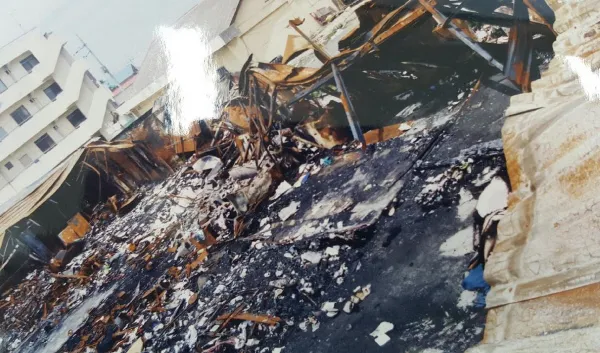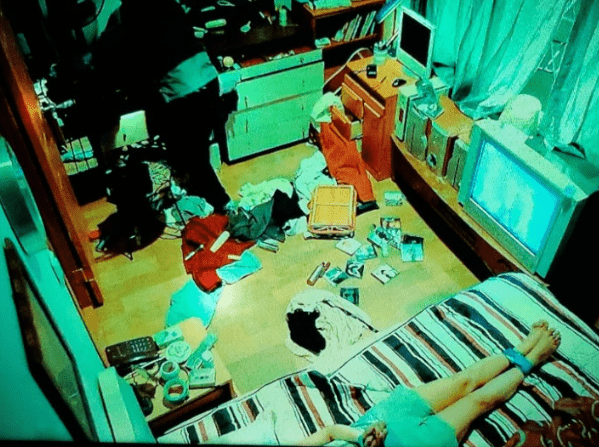The Human-Shaped Object and The Eerily Calm Eyewitnesses
1. THE OPENING FILE: The Object That Fell from the Sky
At approximately 9:20 AM on May 4, 2012, in Anyang City, Gyeonggi Province, South Korea, a chilling incident occurred at a high-rise building known as the H-Officetel (오피스텔, a residential/commercial high-rise).
CCTV footage captured a human-female-shaped object, dressed in what appeared to be a business suit, plummeting from the upper floors.
The subsequent behavior of the building staff and the perplexing details surrounding the object’s disposal turned this tragic event into one of South Korea’s most bizarre and enduring urban mysteries. The central question remains: Was it a body, or was it an object designed to look exactly like one?
2. THE CHILLING SEQUENCE: Evidence Disposal in Broad Daylight
The sequence of events following the impact is where the case truly defies logic, recorded by the building’s own security camera:
- The object struck the ground, splattering blood onto the flower bed below.
- Minutes later, a female janitor discovered the object and reacted with visible shock, immediately alerting management.
- The management staff arrived. Instead of calling the police, one staff member immediately took photos with his cell phone.
- A different staff member then covered the object with a cloth or blanket.
- They proceeded to stuff the object into a large rice sack or burlap bag. The video, though blurry, clearly shows the lower body of the object bending at an unnaturally sharp angle as it is forced into the sack.
- Finally, a male staff member retrieved a handcart and wheeled the sack—containing the potential corpse—to the basement and disposed of it in the garbage dump.
The Core Contradiction: This entire process—from discovery to disposal—was carried out by building staff in the middle of a bright, sunny morning in a busy city, with a level of eerie calmness and efficiency that suggests either extreme desensitization or a deliberate cover-up.
3. THE UNNATURAL ANOMALIES: Body or Doll?
The grotesque disposal fueled two competing theories among online sleuths and eventually, the media:
Theory A: The Realistic Doll
Proponents argue that the staff’s reaction is the strongest evidence. Why would professionals, upon finding a human body, treat it with such casual curiosity and then dispose of it in the trash without calling emergency services (119 or 112)? The extreme passivity suggests they knew it was not human. Furthermore, the object’s torso bent at an 80-degree angle when bagged, which many argue is impossible for an intact human spine.
- Hypothesis: An owner of an expensive, aging sex doll threw it out to avoid proper (and possibly costly) disposal, hoping to pass it off as an accident.
Theory B: The Real Body
This theory centers on the most disturbing fact: The object bled. Unless the doll was deliberately filled with animal blood (such as pig’s blood, as some staff later claimed, though unverified), the splattered fluid points to a human fatality. Furthermore, high-fall trauma can cause bone structures to shatter, resulting in unnaturally flexible joints.
An SBS TV test, recreating the fall with a realistic doll, found the doll’s internal frame actually broke and became rigid, arguing against the ‘flexible doll’ defense.
The Official Investigation Failure: When police finally launched a timid investigation, their requests for evidence were met with obstruction:
- The staff member who took the original photos claimed his cell phone was lost.
- Despite collecting blood samples initially, the police later claimed a subsequent search of the site—requested by the victim’s family—yielded no DNA evidence, leading them to officially close the case as a mere runaway person incident.
4. UNCORED CONNECTION: The Ansan Missing Person Case
The most alarming development came from the potential link to the Anyang Missing Person Case.
- The Victim: Ms. Kim, a woman in her early 30s.
- The Timeline: Ms. Kim disappeared on May 4, 2012—the exact day the object fell.
- The Location: Ms. Kim’s last known location via phone tracking was the H-Officetel in Anyang City—the exact building.
The victim’s family, upon viewing the footage, was convinced the fallen object was their missing relative.
Crucially, YouTuber Kim Won claimed that Korea’s National Forensic Service had indeed tested the blood collected from the flower bed and found it matched the missing woman’s DNA. While the video was later taken down (allegedly to protect the grieving family from a stalled police investigation), the claim sent shockwaves through the community.
Subsequent TV programs (You Are Hooked, Unanswered Questions) confirmed the family was forced to file a death report due to the massive speculation, despite the lack of a body, believing she committed suicide due to prior depression (유서, suicide note, was allegedly found).
5. UncutCore Analysis: The Collective Silence and The Crime
The most important element in this case is not the identity of the fallen object, but the collective silence of the management staff and the police’s bizarre handling of the potential crime scene.
- Intentional Obstruction: The immediate disposal of a suspected human body into the trash is a crime (Destruction/Concealment of a Corpse) and strongly suggests the staff was either ordered to conceal the evidence or was panic-covering for a known suspect.
- The Missing Mobile Phone: The loss of the phone containing the first visual evidence is highly suspicious and a major investigative lapse.
Even if the victim committed suicide, the staff’s action was illegal. However, the uncanny timing, the matching DNA claim, and the fact the police treated it as a simple runaway case points to a much darker scenario.
UncutCore Final Hypothesis: The woman’s death was likely not a random accident or suicide. The fact that the staff’s actions were so brazenly illegal and the police’s subsequent investigation so deliberately minimal suggests a powerful influence—perhaps someone high up in the officetel or closely related to the incident—was able to leverage the staff’s fear and the police’s apathy to ensure the primary evidence (the body) was erased before a proper murder investigation could even begin.
The final chilling question remains: Why did the staff risk jail time to destroy the body of a potential stranger, unless they knew the identity of the killer, or feared the truth more than they feared the law?
CORE Case File: The Busan Duct Tape Murder (2008)
CORE Case File: The Bloody Buckle & The Burned Garage (Seocheon, 2004)

